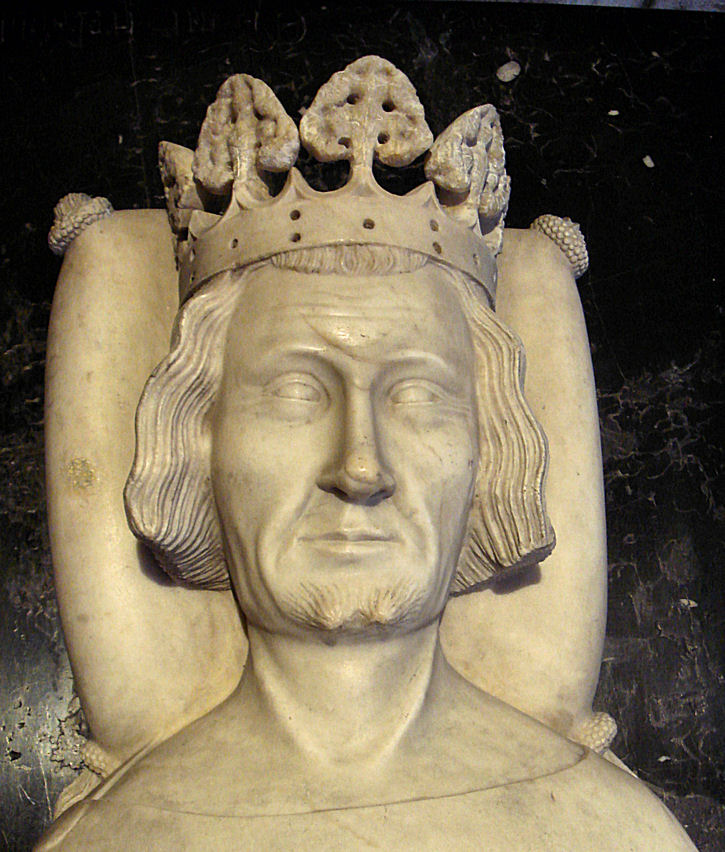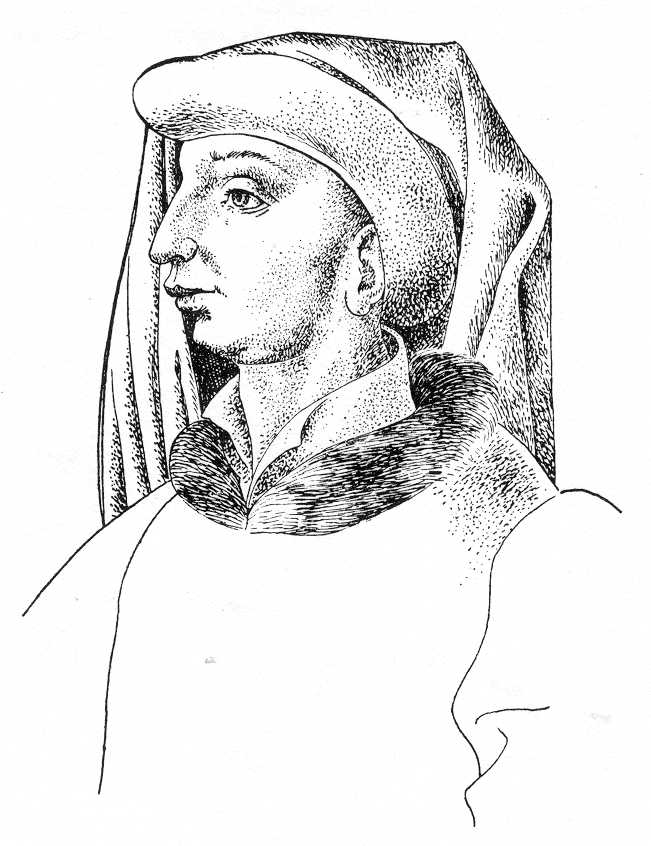[1] Alexios VI's reign would mark a "Second Alexiad" as he, after overthrowing the weak and incompetent leadership of Emperor Andronicus II, would spend his 46-year long reign as Emperor and Autocrat of the Romans trying his best to ensure that Rhomania, weakened by the Fourth Crusade, would regain a position as a major power in a long reign where the Emperor was largely on horseback, campaigning against Latin, Slav, rebel, or Turk. Amongst his greatest achievements as Emperor would be the conquest of the Despotate of Epirus and his crushing of the nascent Osmanli beylik, even if Rhomania by his death, while having recovered from the disaster of the Fourth Crusade, was a mere regional power.
Alexios VI would die in 1341 from ill health and would be succeeded by his son Alexios.
A 16th-century depiction of Emperor and Autocrat Alexios VII
[2] Born in 1300, Alexios was the first born son of Emperor Alexios VI’s second marriage. He was possibly made co-emperor in 1328, reigning alongside his father before being demoted once more, most probably to a defeat in battle against the Epirotes.
When his father died, Alexios succeeded him, though he had to put down a rebellion that was instigated by one of his younger brothers.
In early 1345, Alexios VII launched a campaign against the independent southern Greek states, however, due to his incompetence his army would soon be routed by a combined Greek army. A few days later succumbed to his injuries and was succeeded by his nephew-in-law, Basil Laskaris.
[3] Born in 1321, Basil Laskaris would be one of the last scions of the ancient Nicene house of the Laskarids, which had once ruled the Nicene Empire in Anatolia. Despite their fall to the Palaeologus, the recent rising of the Tarchaneiotes would see the Laskarids rise quickly in opportunity. The Laskarids had been famous for their deeds in Anatolia, beating back the turk often, and it was in this area that the Laskarids would expand and create a new base of power for themselves. The conquest of many Turkic beylics would see the Laskarids adquire many new lands in Bukellarion and Phlagonia. It would be through this that Ioannes Laskaris, strategos of Anatolikon, would see his son Basil married to the niece of Emperor Alexios VII.
Basil and his wife, Irene, would have a fruitful companionship, marked by Irene's intelligence and Basil's respect for her. Despite being more of a friendly "relationship", Basil and Irene would have 7 recorded children. It would be through Irene's claim that Basil would rise to the throne, and this would show during his reign, with Irene being far more than a mere consort during the rule of her husband.
Basil would prove himself up to the task of generalship and emperor-ship. Appealing to Dynastic continuation, Basil would take up the wars of his predecessor and would advance deeply into Southern Greece, restoring it back to the Empire, but an intervention by Venice would see an almost decade of on and off warfare between both states, which the Rhomans would eventually win, restoring their rule to all Greek islands, including Crete, although Cyprus remained in Crusader hands. His warfare-orientated reign would see the rise of a new class of Rhoman soldiery, based on conscription and professional service, mainly rewarded through promises of land in the depopulated Anatolia. Basil would also be the first Emperor to force the Turkish populations of the Empire to pay a blood tax - by giving at least one of their male children in service to the Empire.
Basil's never ending martial energy would see much of Anatolia recovered - with the Empire for the first time in generations reaching the Taurus mountains, with the Rhomans once more asserting dominance over the black sea. Many missionaries were sent into Circassia to Transcausia, and to Tartaria in the Golden horde by him. Basil would transplant many Greeks, Bulgarian and Latin mercenaries, as well as converted fleeing tribes from the North and the Steppes into Anatolia, giving the land a new appeal to the Rhoman state.
Despite his many victories against the westerners and the muslims, Basil would fail in his grandest campaign - the reconquest of Trebizond. The smashing of his army on the Pontic Mountains would see the aged Emperor enter a depression that would eventually take him to his grave. He would be succeeded by his son-in-law, Oshin
.
[4] Oshin, a Prince of Armenia, was son-in-law to Emperor Basil III by his eldest daughter, Rita. Having deemed all of his legitimate sons as lunatics and simpletons, systematically managing them off stage, Basil set Oshin up as defacto heir jure uxoris.
Born in 1341, married in 1369 and had already given Basil three grandchildren by the time he died in 1374. Despite some opposition to his rule from his brothers-in-law and nephews, collectively known as the Basilian Pretenders, Oshin had effectively secured his reign by 1380 which left the remaining decade of his rule for him to focus on civic improvements including reinforcing the defenses of Thessalonica and effectively moving the imperial seat from Constantinople to Thessalonica.
In 1390, Oshin would inherit the Kingdom of Armenian Cilicia from his elder brother and this claim, which could be inherited by a woman, would pass to his children even if they did not become Byzantine Emperor.
Empress Rita outlived her husband, to see him succeeded by their son, Constantine
[5] Constantine XI was born in 1370 as the oldest of Oshin's sons and would become Emperor in 1393 as a result of his father Oshin's death.
As Emperor, Constantine XI's reign, while short, would be one marked by the effective governance of the Empire, especially after returning the capital of the Empire to Constantinople during the first few years of his reign. His reign would also be marked by effective and competent administration, especially with the defeat of the Bulgarians and Serbs in the Haemus and continuation of the consolidation of the Rhoman presence in Anatolia.
While many have speculated about what would have happened had he had more time to be Emperor, it was not to be as he would be killed in Timur's invasion of Anatolia, leaving behind his brother, Justinian, as the new Emperor.
[6] Justinian was the youngest child of Oshin and third son, born in 1384. When his older brothers, Emperor Constantine and Dux Augustine, (b. 1372,) were both killed in the
Battle of Aydin in 1402, Justinian took the throne with the support of his mother, the Dowager Empress, Rita. He was not quite 18 years old.
His two older sisters, however, did not support him.
Theodora, born in 1369, was the oldest child of Oshrin, and had been married to Empress Rita's nephew, _________________, the Dux of Epirus, in 1380, at that time the senior claimant of the Basilian Pretenders. This had confirmed their support for Oshrin's reign. But with the defeat of Constantine to Timur and the loss of Anatolia and Armenia to the Empire, Theodora and the Dux now proclaimed he was the rightful Emperor.
Alexandria, born in 1379, was married to the Bulgarian Emperor, Ivan Umor. They threw their support to Epirus in exchange for a return of the Haemus to the Bulgarians.
The war with Timur was still occurring as the Amir was now battling for the northwest provinces of Asia Minor and the Black Sea coast and was besieging Nicaea. With a two-front war occurring with the Turco-Mongols to the east and south and the Epirus/Bulgaria alliance to the west and north, The Empire was not able to secure Crete, the Peloponnese, and up through the former Duchy of Athens and Venice swept in and swiftly conquered it.
Justinian saw his only hope for the Empire was to sue for peace with Timur. Surprisingly, the Amir was generous in his terms, as he wished to finish in the west and turn east to face China. He agreed to allow Christian pilgrims to visit the Holy Land, now part of the Timurid Empire, to cede the territory in northwest Asia Minor he was occupying in return for the Empire giving up its claims to the former Turkish Beyliks except the ones that bordered the Aegean or the Black Sea, yielding the interior of Anatolia again to Timur's Turkish vassals. (Timur championed the Ghuzz Turks of Mentese who now reformed the Sultanate of Rum in the interior of Anatolia and the southern Mediterranean coast.)
This allowed Justinian to invade the Haemus in 1403. Ivan Umor did not meet Justinian in battle but instead sent Alexandria to negotiate a peace. The Bulgarians sued for peace if they submitted to Constantinople, recognized Justinian as their Emperor, gave up the title Emperor for themselves but took the title of King of the Bulgarians. In return, Justinian recognized the Haemus Mountains as part of the Bulgarian Kingdom but as a vassal of Constantinople.
Now Justinian could turn his full attention to Epirus. Unlike Alexandria, Theodora did not encourage her husband to make peace. A bloody war followed from 1404 through 1408. A peace never was formed with a treaty, like with Timur or Bulgaria, but a ceasefire and truce ended hostilities in the late summer of 1408. All the territory that Epirus had taken from the Empire was restored, but a rump Epirus remained and was now de facto independent, although both sides claimed Epirus was part of the Roman Empire, they just disagreed which government was the legitimate government of the entire Empire.
All through this war, negotiations had occurred with Venice. They were formalized in the Treaty of Athens in 1410. The Greek Isles, except for Crete, were now under the direct control of Constantinople. The Duchy of Athens was restored to independence but formally a vassal of Constantinople, as was the new formed Duchy of the Peloponnese, but Venice was given full rights to trade and establish bases. In reality, the Duchies were under the control of Venice but officially were vassals of Rome. Crete itself was part of the Venetian Empire.
Finally, Justinian had peace on all borders and the Empire was secure, although much smaller than previously.
This was when the Dowager Empress died.
Justinian now knew he needed to marry. He was now 25 and expected many more years to reign. His bride was Anna Vasilievna of Moscow, daughter of Vasily I, the Grand Prince of Moscow. She was now 17 and Muscovy had been one of the only neighboring states to actually declare for Justinian when he took the throne. But now that all surrounding states did, it was to his first ally he turned for a marriage. (Even though that support had been nothing more than declaring a position.)
The Emperor and Empress started a family immediately and had a number of children.
Although it was humiliating that the Greek vassal states were only nominally vassals, the reality of peace with Venice and the presence of Venetian trade in them led to increase prosperity for the Empire. Also peace with the new Sultanate of Rum and the Timurid Empire, meant the Silk Road was re-opened and trade from there added to the Empire's prosperity.
However, the peace and prosperity of Justinian's reign was doomed to fail in 1432 on the death of the heir and grandson of Timur,
Muhammad Sultan Mizra, who'd held all of Timur's empire together from Timur's death in 1405. The western portions of the Timurid Empire fell into chaos, the Silk Road closed again, the Ghuzz attacked the Empire's province of Trezibond, and a new threat demolished the Empire- the Black Plague.
Justinian died of the Plague in 1432 just as the Ghuzz attacked the Empire.




